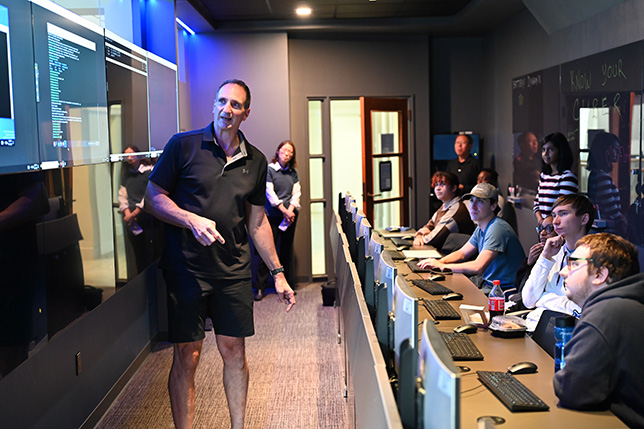Immersive Learning: The Next Frontier of Higher Education
As students develop skills to succeed in the workforce, technologies such as artificial intelligence, virtual reality, and augmented reality are providing a priceless opportunity to learn by doing.
- By Marvin Krislov
- 04/16/24
Soon after Pace University opened its new Cyber Range, a high-tech computer lab that looks more like a CIA-style war room than a traditional classroom, Professor Joe Acampora surveyed the room and asked students if they saw any abnormalities on any of the eight large monitors and dashboards.
On display were a series of lines and coding that no doubt looked fine to a layperson, but to the trained eye showed early clues that there was a looming cyber threat from hackers ready to pounce on a vulnerable network. The task at hand for this class of cyber sleuths was to defend against an imminent cyber attack. In real time. Under real pressure.
It's much like what they would be confronted with on the front lines at a financial institution, health care facility, or government agency.
"We're using it as a training range for collaboration; and preparing students to go into emergency situations and network operations centers," Professor Acampora said of the new range that opened last semester. "They are learning about scenarios under fire."

Pace University's Cyber Range computer lab immerses students in real-life cybersecurity scenarios akin to what they will experience in the workforce. (Photo courtesy of Pace University)
The cyber training is simulated, but designed to develop students' skills through practical, yet challenging scenarios they'll face in the trenches. It's just one example of how we are merging new labs, technologies, and curriculums with real world hands-on training. It's the type of learning environment that didn't exist a few generations ago — one that institutions of higher education around the globe are now embracing with open arms.
To be clear, learning by doing is not a new concept. But increasingly research confirms, or reaffirms, that hands-on and real-life experiences are meaningful ways of teaching people when reinforced by traditional methods. What is evolving at warp speed are the technologies and tools that educators can utilize to engage students in this learning modality.
Just ask Pace cybersecurity student Andrew Kirk, who is graduating in 2024. "We're learning ethical hacking; we're learning the tools the bad guys are using so we can defend against it," Kirk said. "In that sense, this education is priceless."
Immersive or experiential learning is having its moment — one that is here to stay — and the next frontier for higher education is integrating new immersive technologies, such as artificial intelligence (AI), virtual reality (VR), and augmented reality (AR), so that we can best maximize training students for the workforce and the world at large.
It's both an exciting and challenging time. As a sector, we must innovate, invest, adapt, and lead the way as many people — young and old — are questioning the value of a college degree. They want to know that students will graduate with useful, practical, and employable skills. They want to know that college grads will know how to work together, know how to innovate, and know how to stay ahead of the curve.
The investment is worth it, and the return is real. As technologies emerge and evolve, so must our methods and tools. Fortunately, we increasingly have such tools.
As I speak with professors and see what our peers across the country are doing, it's fascinating to see how our industry is meeting these challenges. Arizona State University, for example, is working with a VR startup to teach students new languages in a virtual setting. The University of California, Berkeley, utilizes VR to recreate historical events or cultural sites, providing students with interactive learning opportunities that transcend traditional classroom settings.
Ohio State University employs augmented reality, or AR, to supplement biology lectures by overlaying digital models of organisms onto real-world specimens, offering students new ways of visualizing complex biological structures, systems, and living things. Institutions including MIT and the University of Michigan have developed educational games that challenge students to collaborate with peers, apply theory to practical scenarios, and to work together.
And Purdue University, like Pace where I serve as president, is integrating a variety of simulated health scenarios in emergency and operating room settings as a means of training nurses, who are in great demand. We are sending students into the workforce with more training, more skills, and more confidence. As a result, Pace's nursing graduates, for example, are reporting much higher incomes — offers nearing six figures — that are roughly 60% more than other fields.
Businesses understand the imperative as well. Meta donated equipment and resources to 15 U.S. universities as part of a broader goal to make classrooms more immersive, according to a story by Axios. In the piece, Nick Clegg, Meta's president of Global Affairs, noted this is part of a longer-term strategy by the tech company. "We're now moving from talking about the potential of these immersive technologies in the classroom to actually trying to develop a head of steam," he said.
Apple, Google, and IBM are also shaking up higher education with cool tech tools. Apple is into augmented reality (AR) with ARKit and Swift Playgrounds, which let students dive into interactive learning experiences. Google is integrating its generative AI with databases to enhance the user experience. And IBM is using AI and machine learning to personalize learning, so students get precisely what they need.
In short, they're all making learning a lot more fun and engaging and I'm not only encouraged about the future, but excited by it. By giving our students the opportunity to engage in hands-on learning — led by committed faculty and enabled by a wide range of community and business partners — higher education will continue to thrive.
About the Author
Marvin Krislov president of Pace University, which has campuses in New York City and Westchester County.